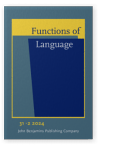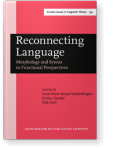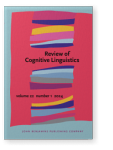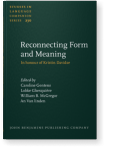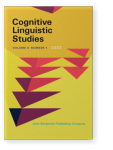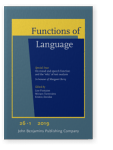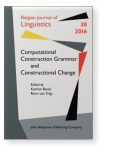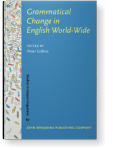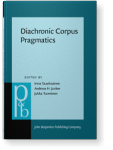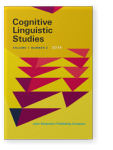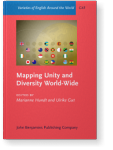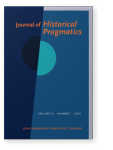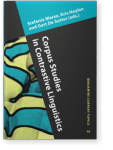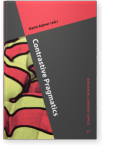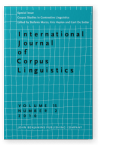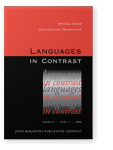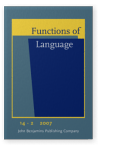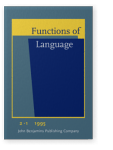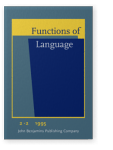Dirk Noël
List of John Benjamins publications for which Dirk Noël plays a role.
Journal
Title
Reconnecting Language: Morphology and Syntax in Functional Perspectives
Edited by Anne-Marie Simon-Vandenbergen, Kristin Davidse and Dirk Noël
[Current Issues in Linguistic Theory, 154] 1997. xiii, 339 pp.
Subjects Functional linguistics | Morphology | Syntax
2024 Culture in a radically usage-based model of language change, with special reference to constructional attrition Review of Cognitive Linguistics 22:1, pp. 100–123 | Article
This article offers theoretical and programmatic reflection on how the impact of culture on language change should be accounted for from a radically usage-based diachronic construction grammatical perspective, with a focus on how cultural change can cause constructions to disappear from a… read more
2023 Chapter 5. Towards a radically usage-based account of constructional attrition: Integrating subtractive language developments in the Entrenchment-and-Conventionalization model Reconnecting Form and Meaning: In honour of Kristin Davidse, Gentens, Caroline, Lobke Ghesquière, William B. McGregor and An Van linden (eds.), pp. 123–144 | Chapter
This chapter reflects on how the gradual disappearance of a construction from a language can be accounted for in a radically usage-based diachronic construction grammar through an exploration of how the phenomenon can be accommodated in Schmid’s (2020) Entrenchment-and-Conventionalization model.… read more
2022 Individual differences in the decline of the Deontic nci construction: A radically usage-based exploratory investigation Cognitive Linguistic Studies 9:1, pp. 1–30 | Article
This paper addresses the question of the (speaker-level) ‘cognitive how’ of (language-level) constructional attrition, defined as a systemic decrease in the occurrence of a construction in the history of a language. Presenting and analysing data from an historical idiolectal corpus on the… read more
2019 The decline of the Deontic nci construction in Late Modern English: Towards a radically usage-based perspective on constructional attrition Cognitive Linguistic Studies 6:1, pp. 22–57 | Article
Starting from a traditional corpus-based investigation of an example of constructional attrition, i.e. of a sustained drop in the frequency of use of a construction in a language’s history, this paper argues that usage data which make abstraction from individual speakers can no more account for… read more
2019 The author and the text in radically usage-based diachronic construction grammar, or why historical linguists have started analysing text again On mood and speech function and the ‘why’ of text analysis: In honour of Margaret Berry, Fontaine, Lise, Miriam Taverniers and Kristin Davidse (eds.), pp. 56–63 | Article
2016 For a radically usage-based diachronic construction grammar Computational Construction Grammar and Constructional Change, Beuls, Katrien and Remi van Trijp (eds.), pp. 39–53 | Article
This squib first sketches the state-of-the-art in diachronic construction grammar by tracing it back to two strands of research which it distinguishes as historical construction grammar and constructionist grammaticalization theory. It then differentiates between usage-based work in diachronic… read more
2015 Recent quantitative changes in the use of modals and quasi-modals in the Hong Kong, British and American printed press: Exploring the potential of Factiva® for the diachronic investigation of World Englishes Grammatical Change in English World-Wide, Collins, Peter (ed.), pp. 437–464 | Article
This chapter uses Factiva® to examine recent evolution in the occurrence of verbal modal expressions in the Hong Kong newspaper South China Morning Post, in contrast with American and British newspapers. Previous research established that the frequency of the modals is decreasing in both British… read more
2014 Tracing the history of deontic NCI patterns in Dutch: A case of polysemy copying Diachronic Corpus Pragmatics, Taavitsainen, Irma, Andreas H. Jucker and Jukka Tuominen (eds.), pp. 213–236 | Article
While the so-called “nominative-and-infinitive” (NCI) is no longer a productive construction in Dutch, the grammar of Present-day Dutch still contains a small set of lexically substantive NCI patterns, most notably geacht worden te and verondersteld worden te. Like their English formal equivalent… read more
2014 A corpus-based diachronic investigation of metaphorical containers of sadness in English Cognitive Linguistic Studies 1:2, pp. 236–251 | Article
This paper addresses the question of conceptual diversity in the seat of emotions via a corpus-based case study of diachronic variation in the metaphorical containers of sadness in English. Data sourced from Literature Online, Early English Books Online and the British National Corpus reveal three… read more
2012 The diverging need (to)’s of Asian Englishes Mapping Unity and Diversity World-Wide: Corpus-Based Studies of New Englishes, Hundt, Marianne and Ulrike Gut (eds.), pp. 55–76 | Article
This paper proffers a corpus-based study of the modal auxiliary need and its lexical counterpart need to in four Asian varieties of English, viz. Hong Kong, Singapore, Philippine and Indian English, in comparison to British and American English. We investigate the distribution of need and need to… read more
2012 The Dutch evidential NCI: A case of constructional attrition Journal of Historical Pragmatics 13:1, pp. 1–28 | Article
Present-day Dutch has two entrenched “grammatical” hearsay evidentials: a construction with zou (originally the past tense form of the verb zullen, cognate with German sollen) and a construction with schijnen (literally, ‘seem’). The closest English equivalent of both constructions is the… read more
2012 Believe-type raising-to-object and raising-to-subject verbs in English and Dutch: A contrastive investigation in diachronic construction grammar Corpus Studies in Contrastive Linguistics, Marzo, Stefania, Kris Heylen and Gert de Sutter (eds.), pp. 7–32 | Article
The so-called ‘raising-to-subject’ pattern that verbs of the type believe can occur in is usually treated as the passive alternative for the so-called ‘raising-to-object’ pattern. In addition to broadening the empirical basis for the opposite claim that the English and Dutch raising-to-subject (or… read more
2011 The nominative and infinitive in English and Dutch: An exercise in contrastive diachronic construction grammar Contrastive Pragmatics, Aijmer, Karin (ed.), pp. 143–180 | Article
The nominative and infinitive (or NCI) is a syntactic pattern that has so far not been given its due in the linguistics of languages that possess structures that could go by that name. In English and Dutch these were probably introduced (or at the very least revived) into the grammar as loans from… read more
2010 Believe-type raising-to-object and raising-to-subject verbs in English and Dutch: A contrastive investigation in diachronic construction grammar Corpus Studies in Contrastive Linguistics, Marzo, Stefania, Kris Heylen and Gert de Sutter (eds.), pp. 157–182 | Article
The so-called ‘raising-to-subject’ pattern that verbs of the type believe can occur in is usually treated as the passive alternative for the so-called ‘raising-to-object’ pattern. In addition to broadening the empirical basis for the opposite claim that the English and Dutch raising-to-subject (or… read more
2009 The nominative and infinitive in English and Dutch: An exercise in contrastive diachronic construction grammar Contrastive Pragmatics, Aijmer, Karin (ed.), pp. 144–181 | Article
The nominative and infinitive (or NCI) is a syntactic pattern that has so far not been given its due in the linguistics of languages that possess structures that could go by that name. In English and Dutch these were probably introduced (or at the very least revived) into the grammar as loans from… read more
2007 Diachronic construction grammar and grammaticalization theory Functions of Language 14:2, pp. 177–202 | Article
Grammaticalization theorists are becoming increasingly aware of the relevance of constructions to their discipline, to the point that one of its leading exponents has recently defined grammaticalization as the creation of new constructions. This is precisely the problem which construction… read more
2001 The passive matrices of English infinitival complement clauses: Evidentials on the road to auxiliarihood? Studies in Language 25:2, pp. 255–296 | Article
English verbs of the believe type, which display variation between that-complements and infinitival complements, more often combine with infinitives as passives than as actives. Though there are good information/thematic structural reasons for this (Noël 1998b), the higher frequency of passive… read more
1995 Beth Levin. English Verb Classes and Alternations: A Preliminary Investigation Functions of Language 2:1, pp. 127–128 | To be specified
1995 Petra Campe. Case, Semantic Roles, and Grammatical Relations: A Comprehensive Bibliography Functions of Language 2:2, pp. 291–292 | To be specified
